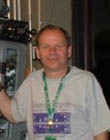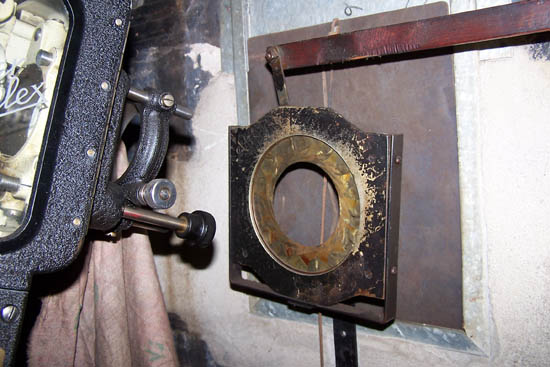|
|
This topic comprises 2 pages: 1 2
|
|
Author
|
Topic: Change-Over Histry Info Needed....
|
|
|
|
|
Tim Reed
Better Projection Pays

Posts: 5246
From: Northampton, PA
Registered: Sep 1999
|
 posted 03-27-2008 08:48 PM
posted 03-27-2008 08:48 PM




I agree with Louis. I've seen some very old installations that had either Weaver or Senator (can't recall) PORTHOLE dousers, which were large irises that alternately closed and opened around the projector ports.
I've also seen low-intensity lamps that had changeover devices attached to the hand dousers, though I can't recall if they were Weaver c/o's.
Both of these devices would go back to the silent days. It might help to look up the patent numbers on Essannay and Thide, et.al, to get some ballpark dates. Thide, I know, goes back at least to the 1930s.
FWIW, Thide was very well-made. I'm doing an installation in downstate NY right now with some used equipment, and there's a Thide c/o on an XL. The insulation on the wiring was falling off to the touch, but the coils were fine. In fact, they looked original because they are very dingy - almost like they've been burned - but I found that wasn't the case! I just rewired the flex cable going to the device and it's as good as new. These had to be the fastest changeovers ever made, it operates in the blink of an eye! WHAM!
Kelmar changeovers are patterned after Thides.
| IP: Logged
|
|
|
|
|
|
|
|
|
|
|
|
|
|
|
|
|
|
|
|
Jim Cassedy
Phenomenal Film Handler

Posts: 1661
From: San Francisco, CA
Registered: Dec 2006
|
 posted 03-28-2008 09:43 AM
posted 03-28-2008 09:43 AM




Many (many!) years ago I worked at an old theater out on Long Island (NY) that was built around 1915.
Their "changeover" system consisted of a long 2x4 beam mounted on some brackets attached to the front projection room wall in such a way that it could slide back-and-forth.
There was a two pieces of black-painted cardboard nailed to the 2x4 and spaced so that when one port was covered by the cardboard, the other was open, and vice versa. To do the "change-over", you slid the 2x4 either left or right to block & unbock alternate portholes.
This required some getting used to. If you did it too fast, the 2x4 jumped out of the brackets. One interesting by-product of this set-up is that becuase the cardboard was several inches in front of the lens, you could also do a sort of "soft-wipe" from one projector to the other if you moved the wooden beam slowly.
It was a neat effect as long as you did it on the right type of scene.
The sound system was even more Rube-Goldberg.
There was an old, open frame tube PA type amp sitting on a chair ( ! ) between the projectors. If you were standing between projectors, you switched the sound by operating a horizontal toggle switch on the front of the amp.
To changeover from the "far" projector, they had a piece of string, one end of which was tied to the toggle switch, and the other end was affixed to a thumb-tack stuck in wall in front of projector #2.
To do the sound change-over, you just pulled the string.
But once again, you had to do it right.... If you pulled
the string too hard, you'd wind up pulling the amp off of
the chair! (I'm not making this up!)
The projectors were very old Simplex'es (Powers) that dated back to the silent days. They were later modifed for sound. They still had the orginal hand-cranks for the projector heads in the parts cabinet.
JimC
| IP: Logged
|
|
|
|
|
|
|
|
All times are Central (GMT -6:00)
|
This topic comprises 2 pages: 1 2
|
Powered by Infopop Corporation
UBB.classicTM
6.3.1.2
The Film-Tech Forums are designed for various members related to the cinema industry to express their opinions, viewpoints and testimonials on various products, services and events based upon speculation, personal knowledge and factual information through use, therefore all views represented here allow no liability upon the publishers of this web site and the owners of said views assume no liability for any ill will resulting from these postings. The posts made here are for educational as well as entertainment purposes and as such anyone viewing this portion of the website must accept these views as statements of the author of that opinion
and agrees to release the authors from any and all liability.
|

 Home
Home
 Products
Products
 Store
Store
 Forum
Forum
 Warehouse
Warehouse
 Contact Us
Contact Us




 Printer-friendly view of this topic
Printer-friendly view of this topic










![[Wink]](wink.gif) Where is that installation? The ones I saw were in the Dunkin Theatre, Cushing, Okla.
Where is that installation? The ones I saw were in the Dunkin Theatre, Cushing, Okla.

![[Razz]](tongue.gif)
![[Eek!]](eek.gif)







